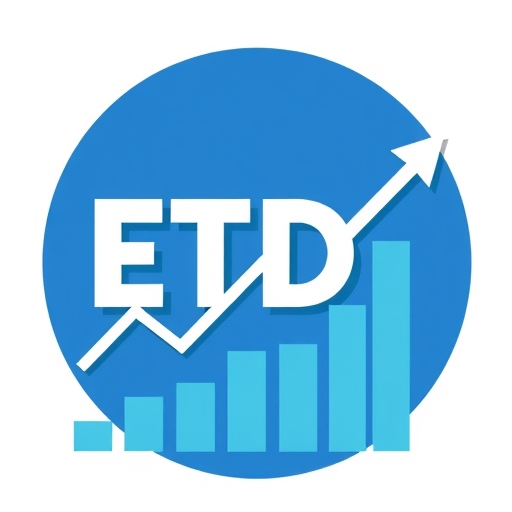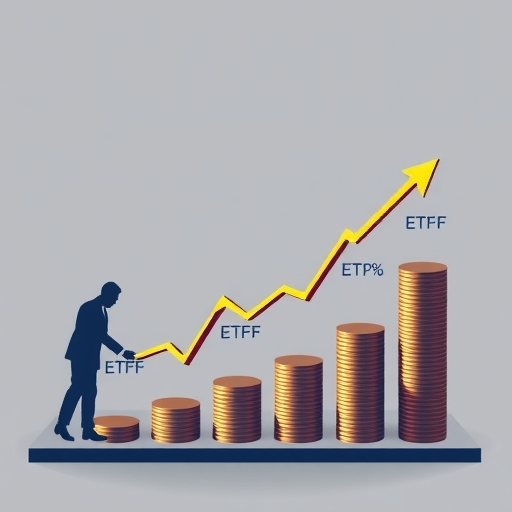Mastering Long-Term Investing: The Essential Guide to ETFs and the Buy-and-Hold Strategy
Are Exchange-Traded Funds (ETFs) truly a good choice for your long-term investment goals? In an increasingly complex financial world, the pursuit of enduring wealth requires a strategy that is both robust and accessible. For many investors, Exchange-Traded Funds (ETFs) have emerged as a cornerstone for such an approach, offering unparalleled diversification, cost-effectiveness, and liquidity. This article will provide a comprehensive overview of how ETFs, particularly when paired with a disciplined “buy-and-hold” strategy, can serve as a powerful engine for wealth accumulation, guiding you through your investment journey from initial planning to strategic adjustments for retirement.
We will demystify what an ETF is, explore the significant advantages it offers for long-term investors, and address key considerations and potential drawbacks. Furthermore, we’ll delve into practical steps for implementing a successful buy-and-hold ETF strategy, from setting your investment goals to understanding popular ETF categories and managing your portfolio over time. Our aim is to equip you with the knowledge to make informed decisions and build a resilient investment portfolio.
ETFs Explained: Your Gateway to Diversified and Cost-Efficient Investing
So, what exactly is an ETF? An Exchange-Traded Fund (ETF) is a type of investment fund that holds various assets, such as stocks, bonds, or commodities, and trades on stock exchanges like a regular stock. Think of it like a basket of different investments that you can buy or sell throughout the day. When you buy a single share of an ETF, you’re essentially getting a small piece of that entire basket, giving you instant diversification without having to buy each individual asset. Most ETFs are designed to track a specific benchmark or index, such as the S&P 500, Nasdaq 100, or MSCI World Index, aiming to replicate its performance rather than trying to beat it. 
To better understand the distinct characteristics of ETFs, it’s helpful to compare them with traditional mutual funds. While both are pooled investment vehicles, their operational structures and trading mechanisms differ significantly.
| Feature | Exchange-Traded Fund (ETF) | Mutual Fund |
|---|---|---|
| Trading | Trades throughout the day on exchanges like stocks (real-time pricing) | Trades once a day after market close (end-of-day pricing) |
| Management | Often passively managed, tracking an index | Often actively managed, aiming to beat an index |
| Expense Ratio | Generally lower | Generally higher |
| Diversification | High, instant diversification across many assets | High, instant diversification across many assets |
| Minimum Investment | Often low (can buy a single share) | Can be high ($1,000s or more) |
| Tax Efficiency | Generally more tax-efficient (lower capital gains distributions) | Can have higher capital gains distributions |
This passive management approach is a key differentiator from actively managed mutual funds. Because ETFs typically don’t require fund managers to constantly research and pick individual securities, their operational costs are generally much lower. This is reflected in a metric called the expense ratio, which is the annual fee charged as a percentage of your investment. Lower expense ratios mean more of your money stays invested, which can significantly enhance your long-term returns. Another important indicator is the tracking error, which measures how closely the ETF’s performance matches its underlying benchmark. A lower tracking error indicates a more efficient fund.
When evaluating potential ETFs for your portfolio, it’s essential to look beyond just the popular names and delve into the underlying metrics that impact long-term performance. Key metrics offer insights into the fund’s efficiency and suitability for your investment objectives.
- Expense Ratio: Always prioritize ETFs with low expense ratios. Even a small difference of 0.1% or 0.2% can lead to substantial savings and increased returns over decades.
- Tracking Error: A low tracking error indicates that the ETF effectively replicates its benchmark’s performance. A high tracking error might suggest inefficiencies in the fund’s management or structure.
- Assets Under Management (AUM): While not a direct performance metric, a higher AUM generally indicates greater liquidity and fund stability, as larger funds are less likely to be closed down.
- Liquidity (Trading Volume): For most long-term buy-and-hold investors, daily trading volume is less critical than for active traders, but sufficient liquidity ensures you can buy or sell shares efficiently when needed.
ETFs offer remarkable flexibility. Unlike mutual funds, which are typically priced once a day after the market closes, you can buy and sell ETF shares throughout market hours at real-time prices. This liquidity makes them highly convenient for many investors. Furthermore, ETFs can be structured as “Distributing” or “Accumulating.” Distributing ETFs pay out dividends and interest income to investors, while Accumulating ETFs automatically reinvest these earnings back into the fund, which can be a powerful driver for compounding growth over extended periods. This feature is particularly attractive for those focused on long-term wealth accumulation, as it harnesses the power of compounding without requiring you to manually reinvest dividends.
Unlocking Long-Term Growth: The Core Advantages of Investing in ETFs
When we talk about long-term investment, the advantages of ETFs truly shine. Their structure and underlying philosophy make them an ideal vehicle for building lasting wealth. Let’s explore why so many investors are turning to ETFs for their long-term portfolios:
- Diversification: Perhaps the most significant advantage, ETFs inherently spread your investment risk. Instead of putting all your eggs in one basket by buying a single stock, an ETF might hold hundreds or even thousands of different securities. This means if one company or sector performs poorly, its impact on your overall portfolio is cushioned. ETFs allow you to diversify across various asset classes (stocks, bonds, commodities), sectors (technology, healthcare, infrastructure), and even geographies (US, Europe, Emerging Markets), significantly reducing stock-specific volatility. This broad exposure is crucial for mitigating risk in any long-term investment strategy.
- Cost Efficiency: As we discussed, ETFs typically boast lower expense ratios than actively managed mutual funds. This difference, often just a fraction of a percent, might seem small initially but can compound into substantial savings over decades. Imagine saving 0.5% per year on a growing portfolio; that money stays invested and continues to generate returns for you. Many brokerage platforms also offer commission-free trading for a wide range of ETFs, further lowering your investment costs and allowing more of your capital to work for you.
- Accessibility: ETFs often have low minimum investment requirements, sometimes allowing you to buy just a single share. This accessibility democratizes investing, enabling individuals with varying capital amounts to participate in broad market opportunities that were once only available to institutional investors or those with significant funds. This makes building a diversified portfolio attainable for almost anyone.
- Liquidity & Convenience: Because ETFs trade like stocks on major exchanges, they offer high liquidity. You can buy or sell shares throughout the trading day at current market prices, providing flexibility that traditional mutual funds often lack. This convenience allows you to adjust your portfolio as needed, though for a buy-and-hold strategy, frequent trading is generally discouraged.
- Compounding Growth: For long-term investors, the power of compounding is transformative. When an ETF distributes dividends or generates capital gains, and these are reinvested (especially in accumulating ETFs), your earnings start to earn their own returns. This snowball effect can dramatically accelerate wealth accumulation over extended periods, turning modest initial investments into substantial sums. We believe this is one of the most powerful forces in finance for long-term investors.
- Tax Efficiency: ETFs generally offer superior tax efficiency compared to mutual funds, particularly regarding capital gains. Their unique “creation and redemption” mechanism allows them to manage capital gains within the fund more effectively, often deferring or reducing taxable distributions to shareholders. While local tax laws vary (e.g., Long-Term Capital Gains (LTCG) and Short-Term Capital Gains (STCG) in India or the US), this structural advantage can lead to more favorable after-tax returns for patient investors.
- Market Stability: Due to their inherent diversification, ETFs generally exhibit lower volatility than individual stocks. While no investment is immune to market downturns, the broad exposure of an ETF helps smooth out the ride, making it easier for investors to endure market fluctuations and stick to their long-term plan. This stability is vital for maintaining investor discipline during turbulent times.
Understanding these profound benefits underscores why ETFs are a cornerstone for many long-term investment strategies, providing a powerful and accessible pathway to financial growth. 
Navigating the ETF Landscape: Strategies for Success and Key Considerations
While ETFs offer compelling advantages, successful long-term investing requires a clear strategy and an understanding of potential challenges. Let’s explore how to implement a buy-and-hold ETF strategy and what to keep in mind.
Implementing a Buy-and-Hold ETF Strategy
- Goal Setting: Before you invest a single dollar, clearly define your personal investment objectives. What are you saving for? Retirement, a down payment, your child’s education? Establish your time horizon (ideally 10-15+ years for long-term investment) and honestly assess your risk tolerance. Are you comfortable with market ups and downs, or do you prefer a more conservative approach? Your goals will shape your entire portfolio strategy.
Having clear investment objectives is the bedrock of any successful long-term strategy. ETFs can be tailored to suit a wide range of financial aspirations.
- Retirement Savings: Many investors use broad market or target-date ETFs to build a substantial nest egg for their post-working years.
- Education Funding: For children’s college education, growth-oriented ETFs can help capital appreciate over a long horizon.
- Home Down Payment: For shorter to medium-term goals (e.g., 5-10 years), a balanced portfolio of equity and bond ETFs might be appropriate to grow funds while managing risk.
- Wealth Accumulation: Simply building general wealth for future flexibility, often through diversified global equity ETFs.
- Asset Allocation: This is the cornerstone of any robust investment strategy. Asset allocation involves strategically distributing your investments across different asset classes, such as equities (stocks), bonds, and potentially commodities or real estate. For example, a younger investor with a long time horizon might opt for a higher percentage in equity-focused ETFs (e.g., 70-80% stocks, 20-30% bonds), while someone nearing retirement might choose a more conservative mix. Diversification across these classes helps balance risk and return.
Determining your optimal asset allocation depends heavily on your age, risk tolerance, and time horizon. Here’s a simplified example of how asset allocation might shift over an investor’s lifecycle.
| Investor Profile | Equity ETFs (Growth) | Bond ETFs (Stability) | Other ETFs (e.g., Commodities, REITs) | Typical Goal |
|---|---|---|---|---|
| Young (20s-30s) | 70-90% | 10-20% | 0-10% | Aggressive growth, long horizon |
| Mid-Career (40s-50s) | 50-70% | 25-40% | 5-10% | Balanced growth and capital preservation |
| Pre-Retirement (50s-early 60s) | 30-50% | 45-65% | 0-5% | Capital preservation, income focus |
| Retirement (60s+) | 20-40% | 55-75% | 0-5% | Income generation, wealth preservation |
These are general guidelines; individual circumstances will always dictate the most appropriate allocation. Consult a financial advisor to tailor a strategy specific to your needs.
- ETF Selection: Choose ETFs that align with your intended asset mix and investment goals. For broad market exposure, index-tracking ETFs are popular choices. Examples include the iShares S&P 500 UCITS ETF for US large-cap exposure, the iShares Nasdaq 100 UCITS ETF for technology-heavy growth, or the iShares Core MSCI World UCITS ETF for global diversification. You might also consider sector-specific ETFs like the VanEck Semiconductor ETF (SMH) or the Vanguard Information Technology ETF (VGT) if you want to focus on particular industries, but these carry higher sector-specific risk. For stability, consider bond ETFs like those tracking US Treasury bonds, and for inflation hedging, commodity-backed ETFs such as iShares Physical Gold.
- Regular Monitoring and Rebalancing: Your portfolio’s initial asset allocation won’t stay perfectly aligned over time due to varying market performance. Therefore, rebalancing is crucial. Periodically (e.g., once a year), review your portfolio’s composition. If equities have performed exceptionally well, they might now represent a larger percentage of your portfolio than you initially intended, increasing your risk. Rebalancing means selling a portion of your outperforming assets and buying more of your underperforming ones to bring your portfolio back to its target allocation and desired risk profile. This disciplined approach helps you “buy low and sell high” automatically.
- Entry Methods: You can invest a lump sum if you have significant capital upfront. Alternatively, many investors utilize Systematic Investment Plans (SIPs), where you invest a fixed amount regularly (e.g., monthly). SIPs leverage dollar-cost averaging, meaning you buy more shares when prices are low and fewer when prices are high, which can help mitigate the risk of market timing and smooth out your average purchase price over time.
Implementing a well-thought-out buy-and-hold ETF strategy requires patience and adherence to your plan, even when market conditions are challenging. 
Considerations and Potential Drawbacks of ETF Investing
While the benefits are clear, it’s equally important to understand the other side of the coin:
- Discipline Required: The “buy-and-hold” strategy for ETFs demands significant investor discipline. You must maintain a long-term perspective and avoid impulsive selling during market downturns or crises. Seeing your portfolio value drop can be unsettling, but panic selling often locks in losses and prevents you from benefiting from the inevitable market recovery.
- Performance Variation: While broad market ETFs offer consistent, market-average returns, they may underperform specific high-growth stocks or market-leading companies during strong bull markets. If a few individual stocks skyrocket, a diversified ETF will capture some of that growth, but not the concentrated gains of a single winner.
- Risk of Loss: It’s vital to remember that diversification does not eliminate investment risk. ETFs can still experience losses if the underlying assets decline in value. For example, a global stock market ETF will fall if global markets decline. Your capital is always at risk, and investment returns are never guaranteed.
- Portfolio Alignment: It is crucial to select ETFs that align with your overall portfolio strategy and risk tolerance. Choosing the wrong ETF for your goals can lead to suboptimal returns or expose you to more risk than you’re comfortable with. Always research an ETF’s holdings, expense ratio, and tracking error before investing.
To maximize your chances of success with ETFs and a buy-and-hold strategy, it’s wise to be aware of common pitfalls that can derail even well-intentioned investors.
- Chasing Performance: Avoid the temptation to constantly switch ETFs based on recent strong performance. This often leads to buying high and selling low, undermining the long-term benefits of compounding.
- Over-diversification or Under-diversification: While diversification is key, owning too many overlapping ETFs can complicate your portfolio without adding significant benefit. Conversely, having too few or overly concentrated ETFs can expose you to unnecessary risk.
- Ignoring Fees: Even small expense ratios can erode returns over decades. Always compare fees and choose cost-efficient funds, especially for long-term core holdings.
- Lack of Rebalancing: Failing to periodically rebalance your portfolio can lead to an unintended increase in risk or a deviation from your target asset allocation.
- Emotional Investing: Panicking during market downturns and selling off investments is one of the most detrimental mistakes. Stick to your long-term plan and trust the power of recovery.
Popular ETF Categories and Examples
The ETF universe is vast and growing. Here are some popular categories and specific examples that you might consider for your long-term investment portfolio:
- Index-Tracking ETFs: These funds provide broad market exposure.
- iShares S&P 500 UCITS ETF: Tracks the performance of 500 large U.S. companies.
- iShares Nasdaq 100 UCITS ETF / Invesco QQQ Trust (QQQ): Focuses on the 100 largest non-financial companies listed on the Nasdaq, often tech-heavy.
- iShares Core MSCI World UCITS ETF: Offers exposure to large and mid-cap companies across developed markets worldwide.
- Sector-Specific ETFs: For targeted exposure to particular industries.
- VanEck Semiconductor ETF (SMH): Invests in companies primarily involved in the semiconductor industry.
- Vanguard Information Technology ETF (VGT) / Technology Select Sector SPDR Fund (XLK): Concentrates on the technology sector.
- Commodity-Backed ETFs: For exposure to raw materials.
- iShares Physical Gold / iShares Physical Silver: Invests directly in physical gold or silver bullion.
- Bond ETFs: For fixed-income exposure and portfolio stability.
- ETFs tracking US Treasury bonds or diversified corporate bond portfolios.
- Dividend Aristocrat ETFs: Focus on companies with a long history of consistent dividend growth.
- Emerging Market ETFs: Provide exposure to growth opportunities in developing economies, though often with higher volatility.
Understanding these categories and examples can help you build a diversified long-term portfolio tailored to your investment objectives. Remember to always research the specific ETF’s holdings and fees before making an investment decision.
To further illustrate the diverse landscape of ETFs, here’s a table summarizing some of the most common categories and their primary investment objectives, which can guide your selection process.
| ETF Category | Primary Objective | Examples | Risk Profile |
|---|---|---|---|
| Broad Market Index | Track major stock market indices | S&P 500, MSCI World, Total Stock Market | Moderate to High (equities) |
| Bond | Income generation, capital preservation | US Treasuries, Corporate Bonds, Municipal Bonds | Low to Moderate (fixed income) |
| Sector/Industry | Target specific economic sectors | Technology, Healthcare, Energy, Financials | High (concentrated risk) |
| International/Emerging Markets | Exposure to global or developing economies | MSCI EAFE, MSCI Emerging Markets | Moderate to High (currency, political risk) |
| Commodity | Hedge against inflation, exposure to raw materials | Gold, Silver, Oil, Agriculture | Moderate to High (volatility) |
| Dividend | Income and growth from dividend-paying stocks | Dividend Aristocrats, High Dividend Yield | Moderate (equity income) |
Building Your Retirement Nest Egg: Lifecycle Adjustments and Future Planning with ETFs
Your investment journey is not static; it evolves as your life circumstances and goals change. The beauty of ETFs within a long-term, buy-and-hold strategy is their adaptability. What works for a 25-year-old just starting their career will likely differ from the optimal portfolio for a 55-year-old nearing retirement. We often refer to this as lifecycle investing, where your asset allocation gradually shifts over time.
As you approach major life goals, particularly retirement, a strategic shift in your ETF portfolio becomes prudent. This process is often called de-risking. In your younger years, with a long time horizon, you can typically afford to take on more risk, meaning a higher allocation to growth-oriented equity ETFs. These might include broad market index funds (like S&P 500 or MSCI World ETFs) or even some sector-specific ETFs that align with long-term growth trends (e.g., technology, infrastructure). The goal here is aggressive wealth accumulation, leveraging compounding growth to its fullest potential.
However, as retirement approaches (e.g., within 5-10 years), the focus typically shifts from aggressive growth to capital preservation and income generation. At this stage, you would gradually reduce your exposure to volatile equity ETFs and increase your allocation to more conservative investments. This might involve shifting from high-growth equity ETFs to more stable bond ETFs, which generally provide more predictable income and lower volatility. Some investors also increase their allocation to cash or short-term fixed income ETFs to ensure liquidity for immediate retirement needs. This gradual adjustment helps safeguard the wealth you’ve accumulated over decades, ensuring it’s there when you need it. 
Continuous learning and monitoring are also vital. Stay informed about market trends, but resist the urge to react impulsively to short-term news. Regularly review your portfolio, perhaps annually, to ensure it still aligns with your current goals and risk tolerance. Remember, the core of a successful long-term ETF strategy lies in patience, discipline, and a willingness to adapt your portfolio as your life journey unfolds. We believe that by thoughtfully managing your ETF investments throughout your lifetime, you can confidently chart a course towards a secure and prosperous financial future.
Conclusion
In summary, Exchange-Traded Funds, when strategically employed within a disciplined buy-and-hold framework, stand out as a premier vehicle for achieving long-term financial goals. Their blend of instant diversification, low costs, real-time liquidity, and tax efficiency empowers investors to build resilient portfolios capable of weathering market cycles and capitalizing on the powerful force of compounding growth. We’ve explored how understanding ETF mechanics, embracing a patient investment strategy, selecting appropriate funds, and making lifecycle adjustments are all crucial components of this success.
By embracing these principles and adapting your strategy through different life stages, you can confidently chart a course towards a secure and prosperous financial future. The journey of long-term investment with ETFs is not about predicting the market, but about participating in its growth over time with a well-structured and consistent approach.
Disclaimer: This article is for informational and educational purposes only and does not constitute financial advice. Investing in Exchange-Traded Funds (ETFs) or any financial instrument involves risks, including the potential loss of principal. Past performance is not indicative of future results. Always consult with a qualified financial advisor before making any investment decisions, and consider your personal financial situation and risk tolerance.
Frequently Asked Questions (FAQ)
Q: What is the main difference between an ETF and a mutual fund?
A: ETFs trade throughout the day on stock exchanges like individual stocks and often have lower expense ratios due to their passive management style. Mutual funds, in contrast, are typically priced once a day after the market closes and are often actively managed, leading to potentially higher fees.
Q: How does dollar-cost averaging work with ETFs?
A: Dollar-cost averaging (DCA) is an investment strategy where you invest a fixed amount of money into an ETF at regular intervals (e.g., monthly), regardless of its share price. This approach helps reduce the risk of market timing because you buy more shares when prices are low and fewer when prices are high, ultimately averaging out your purchase price over time.
Q: Is an ETF suitable for short-term trading?
A: While ETFs offer liquidity and can be traded throughout the day, this article primarily advocates for their use in a long-term, buy-and-hold strategy due to their diversification, cost-efficiency, and compounding growth potential. Short-term trading carries higher risks, often involves attempting to time the market, and is not typically recommended for most investors focused on long-term wealth accumulation.



No responses yet